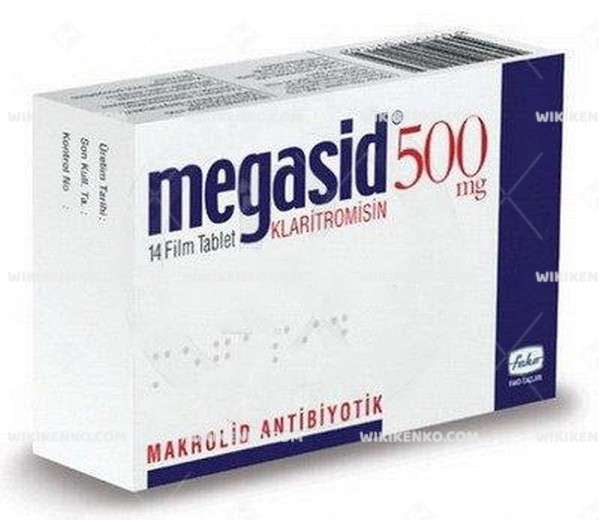Description
Ingredients
Megasid Film Tablet contains a vital active ingredient, clarithromycin, with each tablet delivering 500 mg of this antibiotic. However, the tablet is more than just its active component. It includes several excipients, each serving a specific purpose in pharmaceutical formulation.
Excipients in Megasid Film Tablet
- Sodium Starch Glycolate (Explotab): This starch variant acts as a disintegrant, facilitating tablet breakdown and prompt release of the active ingredient upon contact with water.
- Hydroxypropyl Cellulose: Derived from cellulose, it serves as a binder and filler within the tablet.
- Microcrystalline Cellulose (Avicel pH 101 and Avicel pH 112): These refined wood pulp derivatives function as texturizers and anti-caking agents.
- Sodium Stearyl Fumarate: This compound acts as a lubricant within the tablet.
- Talc: Employed as a glidant, talc enhances the flow properties of the powder mixture during tablet manufacturing.
- Stearic Acid: Another lubricant in tablet formulation.
- Colloidal Silicon Dioxide (HDK-N20): Functioning as both a glidant and anti-caking agent, it contributes to tablet stability.
- Ethyl Alcohol: This solvent is used in the film coating process.
- Opadry White Y-1-7000 (HPMC 2910/Hypromellose 5 cP, Titanium Dioxide, Macrogol /PEG 400): This film coating enhances tablet appearance and ease of swallowing.
- Sorbic Acid: Acting as a preservative, it helps maintain tablet integrity.
- Banana Flavor: Added for improved taste.
- Deionized Water: Serves as a solvent in the tablet’s manufacturing process.
It’s important to note that while this list provides insights into the tablet’s composition, additional details may be available. Always consult a healthcare professional for comprehensive information.
Indications
Megasid Film Tablet finds application in treating various infections caused by susceptible microorganisms in adults and children over 12 years old. Its indications include:
- Upper Respiratory Tract Infections: This encompasses conditions such as pharyngitis (throat inflammation) and tonsillitis (tonsil inflammation) caused by Streptococcus pyogenes, and acute maxillary sinusitis (sinus inflammation) resulting from Haemophilus influenzae, Moraxella catarrhalis, or Streptococcus pneumoniae.
- Lower Respiratory Tract Infections: Megasid effectively treats acute bacterial exacerbation of chronic bronchitis and pneumonia caused by Haemophilus influenzae, Mycoplasma pneumoniae, Streptococcus pneumoniae, or Chlamydia pneumoniae.
- Uncomplicated Skin and Soft Tissue Infections: Staphylococcus aureus or Streptococcus pyogenes infections are effectively addressed.
- Mycobacterial Infections: Effective against infections caused by Mycobacteria, it plays a crucial role in the prevention of Mycobacterium avium complex (MAC) infection in some AIDS patients.
- Duodenal Ulcer Recurrence Reduction: Megasid is employed for eradicating H. Pylori, a bacterium associated with duodenal ulcers.
- Dental Infections: Its application extends to the treatment of dental infections.
The versatility of Megasid Film Tablet in combating such a wide range of infections underscores its importance in clinical practice.
Contraindications
Certain individuals should exercise caution or avoid Megasid Film Tablet altogether. This includes patients:
- Allergic to clarithromycin, erythromycin, or other macrolide antibiotics, or any of the tablet’s ingredients.
- With a history of QT prolongation or heart rhythm disorders.
Dosage
The appropriate dosage of Megasid Film Tablet hinges on multiple factors, including the type and severity of the infection, the patient’s age, and overall health. General dosage guidelines are as follows:
- For adults, the typical dose consists of 500 mg tablets, administered every 8 hours. In severe infections, the dosage can be increased to 2 tablets daily. Treatment duration typically spans 7-14 days.
- Pediatric patients under 12 years old are better suited for a pediatric suspension form of Megasid.
- For prevention or treatment of Mycobacterium avium complex (MAC) infection, the standard dose is usually 7.5 milligrams (mg) per kilogram (kg) of body weight, administered every twelve hours for 10 days.
These recommendations serve as a general guideline, and precise dosages may vary. Always adhere to the instructions provided by your healthcare provider when using Megasid Film Tablet.
Conclusion
Megasid Film Tablet, with its core component clarithromycin and a host of excipients, emerges as a versatile antibiotic pharmaceutical. Its broad spectrum of applications in treating diverse infections makes it a valuable tool in the medical arsenal. However, it’s vital to exercise caution, adhere to recommended dosages, and consult a healthcare professional for comprehensive guidance.
Please note that the information provided serves as an overview, and for more in-depth details, consulting a healthcare expert is advised.
At a glance
| Property | Details |
|---|---|
| Type | Antibiotic (Macrolide) |
| Active Ingredient | Clarithromycin (500 mg per tablet) |
| Composition | Clarithromycin, Excipients |
| Indications | Upper Respiratory Tract Infections, Lower Respiratory Tract Infections, Skin and Soft Tissue Infections, Mycobacterial Infections, Prevention in AIDS Patients, Duodenal Ulcer Recurrence Reduction, Dental Infections |
| Contraindications | Allergy to Clarithromycin or Macrolide Antibiotics, History of QT Prolongation or Heart Rhythm Disorders |
| Packaging | 14 Film-Coated Tablets |













Reviews
There are no reviews yet.